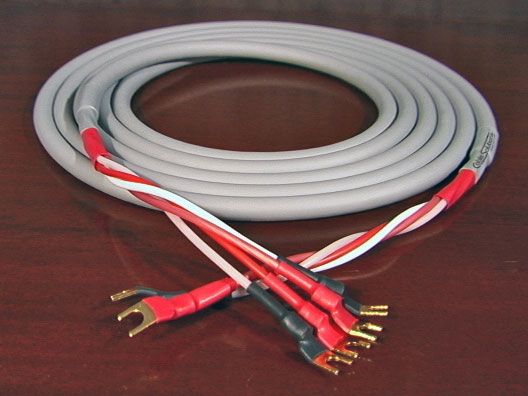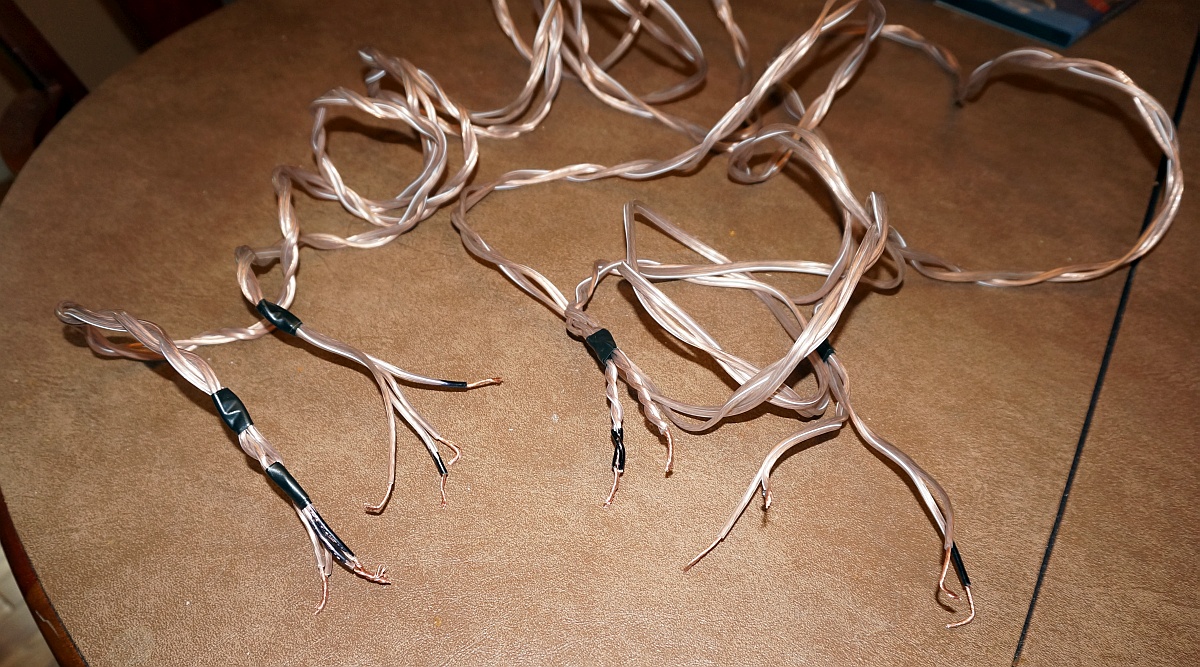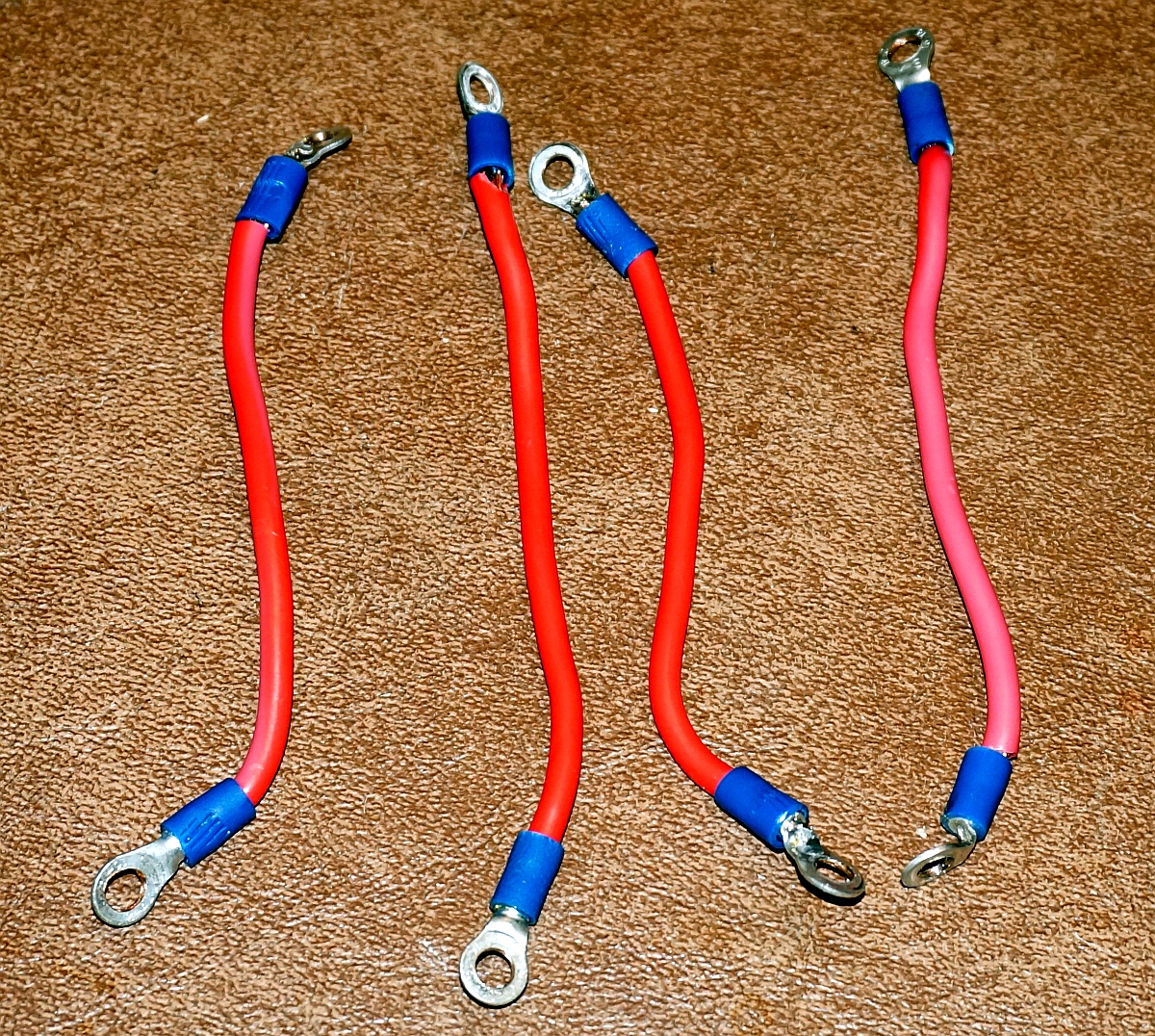WTB: Bi-wire speaker cables with spades/rings on the speaker side or just spades...

Mystery
Posts: 2,546
Okay, I'm about to buy some Canare quad cables and some spades to make a pair bi-wire cables.
Not looking for pricey stuffs but if anyone has similar quality cable, I may get more for my $$.
If not, 4 pairs of spades/rings is also under consideration.
The other side that goes to amp can be anything or nothing.
I think 10 ft. is what I need more or less.
Thanks guys.
Not looking for pricey stuffs but if anyone has similar quality cable, I may get more for my $$.
If not, 4 pairs of spades/rings is also under consideration.
The other side that goes to amp can be anything or nothing.
I think 10 ft. is what I need more or less.
Thanks guys.
Klipsch RB81, KG3.5, B&W DM602.5, Polk.
Subwoofers: Klipsch RW10, Triad ProSub Bronze.
Comments
-
Is there a reason you want bi-wires ? You could just get single runs and use a better quality jumper. Whats the budget anyway ? 10 footers bi-wired of decent quality you won't find in the bargain basement bin.HT SYSTEM-
Sony 850c 4k
Pioneer elite vhx 21
Sony 4k BRP
SVS SB-2000
Polk Sig. 20's
Polk FX500 surrounds
Cables-
Acoustic zen Satori speaker cables
Acoustic zen Matrix 2 IC's
Wireworld eclipse 7 ic's
Audio metallurgy ga-o digital cable
Kitchen
Sonos zp90
Grant Fidelity tube dac
B&k 1420
lsi 9's -
Is there a reason you want bi-wires ? You could just get single runs and use a better quality jumper. Whats the budget anyway ? 10 footers bi-wired of decent quality you won't find in the bargain basement bin.
Yes, Vandersteen 3A Signatures' crossovers are specifically made for bi-wiring.What is bi-wiring and what are the advantages?
Bi-wiring uses two separate sets of speaker cables to connect a single pair of loudspeakers to an amplifier. Coupled with a crossover designed specifically for bi-wiring, it offers many of the advantages of bi-amplifying the speakers with two separate amplifiers without the cost and complexity of two amplifiers.
We began experimenting with bi-wiring back in the early '80s, an era when horizontal bi-amplification was considered the ultimate way to drive quality loudspeakers. (Horizontal bi-amplification used one amplifier to drive the low-frequency section of a speaker and a second amplifier to drive the high-frequency section.) We noted that speakers sounded better when bi-amplified by two amplifiers than when driven by a single amplifier. Surprisingly, this superior performance was evident even when the speakers were bi-amplified by two identical amplifiers at a low volume level and the amplifiers were each driven full-range without an electronic crossover. We initially believed that the double power supplies and other components of two amplifiers were responsible for the improvement, however building amplifiers with twice the power supply and doubling-up on other critical components failed to provide the bi-amplification benefit.
So we looked at the speaker wires. With two amplifiers, bi-amplification used two sets of speaker cables so we experimented with doubling-up the speaker wires and with larger wire. Neither duplicated the bi-amplification improvements. Then we considered that in a bi-amplified system, one set of wires carries the low-frequencies and the other set of wires carries the high-frequencies. We modified a speaker's crossovers to accept two sets of cables and present different load characteristics to each set so that the low-frequencies would be carried by one set of wires and the high-frequencies by the other set of wires. Finally we heard the sonic improvements of bi-amplification with a single amplifier.
Additional experiments with a Hall Effect probe revealed that high-current bass frequencies created a measurable field around the wires that expanded and collapsed with the signal. We believe that this dynamic field modulates the smaller signals, especially the very low level treble frequencies. With the high-current signal (Bass) separated from the low-current signal (Treble) this small signal modulation was eliminated as long as the cables were separated by at least an inch or two. (To keep the treble cable out of the field surrounding the bass cable.)
The crossovers in Vandersteen bi-wirable speakers are engineered with completely separate high-pass and low-pass sections. The bass inputs pass low-frequencies to the woofers, but become more and more resistive at higher frequencies. The treble inputs pass high-frequencies to the midrange and tweeter, but become more and more resistive at low-frequencies. The output from the amplifier always takes the path of least resistance so deep bass frequencies go to the bass input (Low impedance at low-frequencies) rather than to the treble inputs (High impedance at low frequencies). For the same reason, treble frequencies go to the treble input (Low impedance at high-frequencies) rather than to the bass inputs (High impedance at high-frequencies). At the actual crossover frequency, the output from the amplifier would be divided equally between the two inputs as they would both have the same impedance at that frequency. Because of the different reflected impedances of the cables, the crossover between the woofer and midrange actually occurs at the wire ends where they connect to the amplifier.
The benefits of bi-wiring are most obvious in the midrange and treble. The low-current signal to the midrange and tweeter drivers does not have to travel on the same wire as the high-current woofer signal. The field fluctuations and signal regeneration of the high-current low-frequencies are prevented from distorting or masking the low-current high-frequencies. The back EMF (Electro-Mechanical Force) from the large woofer cannot affect the small-signal upper frequencies since they do not share the same wires.
The effects of bi-wiring are not subtle. The improvements are large enough that a bi-wire set of moderately priced cable will usually sound better than a single run of more expensive cable.
All the cables in a bi-wire set must be the same. There is often great temptation to use a wire known for good bass response on the woofer inputs and a different wire known for good treble response on the midrange/tweeter inputs. This will cause the different sonic characteristics of the two wires in the middle frequencies to interfere with the proper blending of the woofer and midrange driver through the crossover point. The consistency of the sound will be severely affected as the different sounding woofer and midrange drivers conflict with each other in the frequency range where our ears are most sensitive to sonic anomalies. The disappointing result is a vague image, a lack of transparency through the midrange and lower treble and a loss of detail and clarity.
Some of the benefits of bi-wiring are from the physical separation of the high-current bass and low-current midrange/tweeter wires. So-called bi-wire cables that combine the wires in one sheath do not offer the full advantages of true bi-wiring although they may be an excellent choice for mono-wiring the speakers.
The cables should all be the same length. This is not due to the time that the signal takes to travel through a cable, but rather that two different lengths of the same cable will sound different. If the cables connecting one speaker are a different length than the cables connecting the other speaker, the resulting difference in sound between the two speakers will compromise the imaging and coherence of the system. If different lengths of cable are used for the bass and midrange/tweeter inputs of the speakers, the effects will be similar to those experienced when using two different cables as described above.
Since short runs of speaker cable sound better than long runs, consider placing your electronics between the speakers rather than off to one side. If for convenience or aesthetic considerations, the electronics must be located a considerable distance from the speakers, it is usually preferable to place the amplifier between the speakers and use long interconnect cables and short speaker wire.
So looking cables like these:
Klipsch RB81, KG3.5, B&W DM602.5, Polk.
Subwoofers: Klipsch RW10, Triad ProSub Bronze. -
I have a used 10 ft. pair of our Douglas Connection 12AWG Bi-Wire OFHC cables if you are interested. They were sold to a customer who decided to upgrade to a more expensive set, and traded them in. Retail on this set is $286.64 but I'll give you a good deal on them. PM me if you are interested.

Sunfire Theater Grand IV
Sunfire Cinema Grand Signature
SRS 2.1TL
SDA 2BTL's
CSiA6
FXiA4
FXiA6
SDA 2A's
Monitor 10A's
http://www.douglasconnection.com -
I would take Doug up on that generous offer....won't do much better than that for basically new cables.HT SYSTEM-
Sony 850c 4k
Pioneer elite vhx 21
Sony 4k BRP
SVS SB-2000
Polk Sig. 20's
Polk FX500 surrounds
Cables-
Acoustic zen Satori speaker cables
Acoustic zen Matrix 2 IC's
Wireworld eclipse 7 ic's
Audio metallurgy ga-o digital cable
Kitchen
Sonos zp90
Grant Fidelity tube dac
B&k 1420
lsi 9's -
Coupled with a crossover designed specifically for bi-wiring
Bunch of marketing hype, any speaker with two sets of binding posts have a crossover designed specifically for bi-wiring.Political Correctness'.........defined
"A doctrine fostered by a delusional, illogical minority and rabidly promoted by an unscrupulous mainstream media, which holds forth the proposition that it is entirely possible to pick up a t-u-r-d by the clean end."
President of Club Polk -
I had a 50 feet spool of 16 awg copper wire lying around so I made a bi-wire using that.
Overall cable length is little over 11 feet with bare ends on both sides.

Existing jumper had non-copper rings so bare wire should be better.
Listened to few tracks and I think they are cleaner and more open vocals with better instrument separation but that could be my mind playing games.
I'm not jumping terminals again just to check that so it's what it is.
At least now they are bi-wired as suggested.
And keeping eyes for budget bi-wire.
Klipsch RB81, KG3.5, B&W DM602.5, Polk.
Subwoofers: Klipsch RW10, Triad ProSub Bronze.


